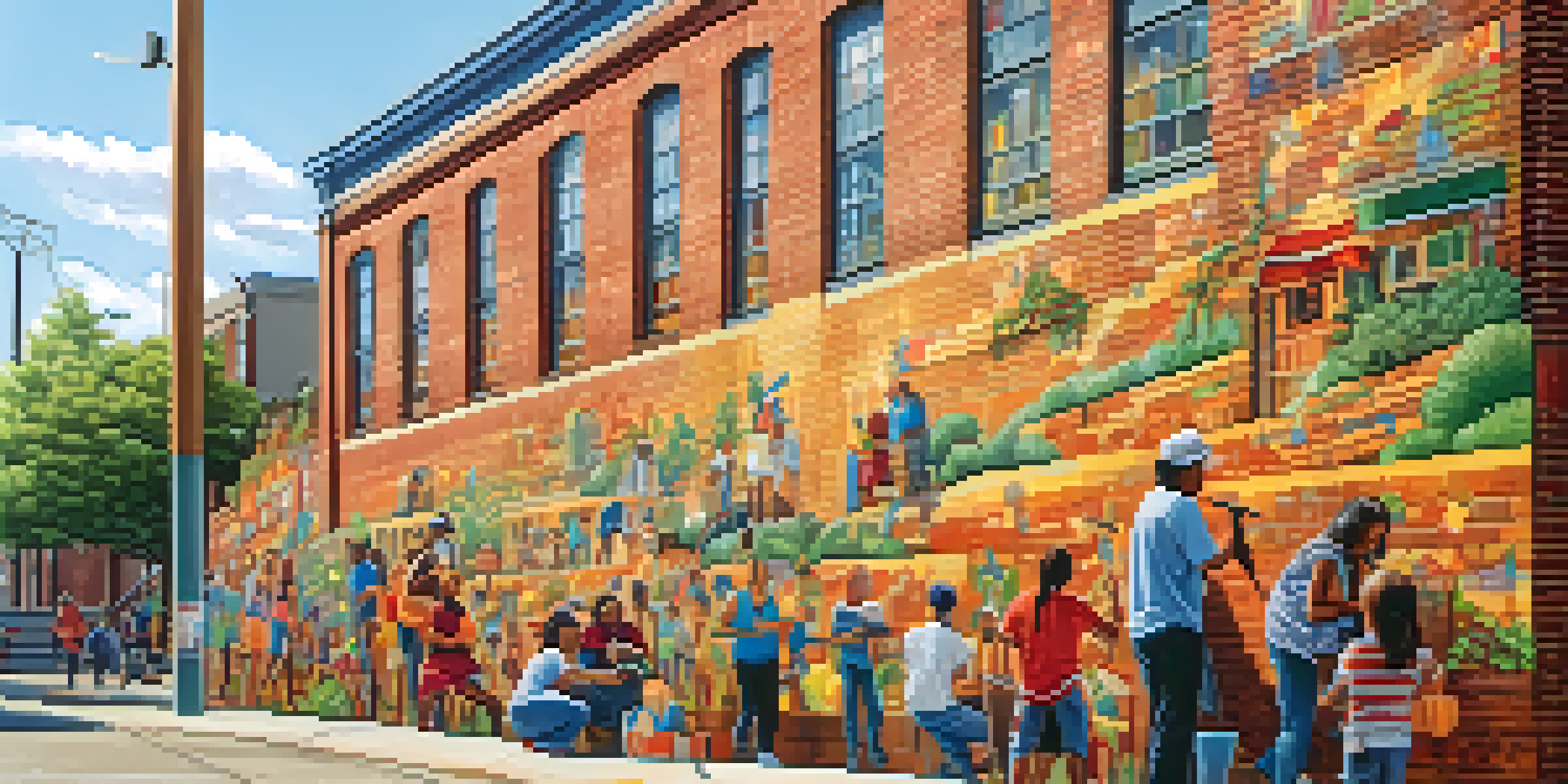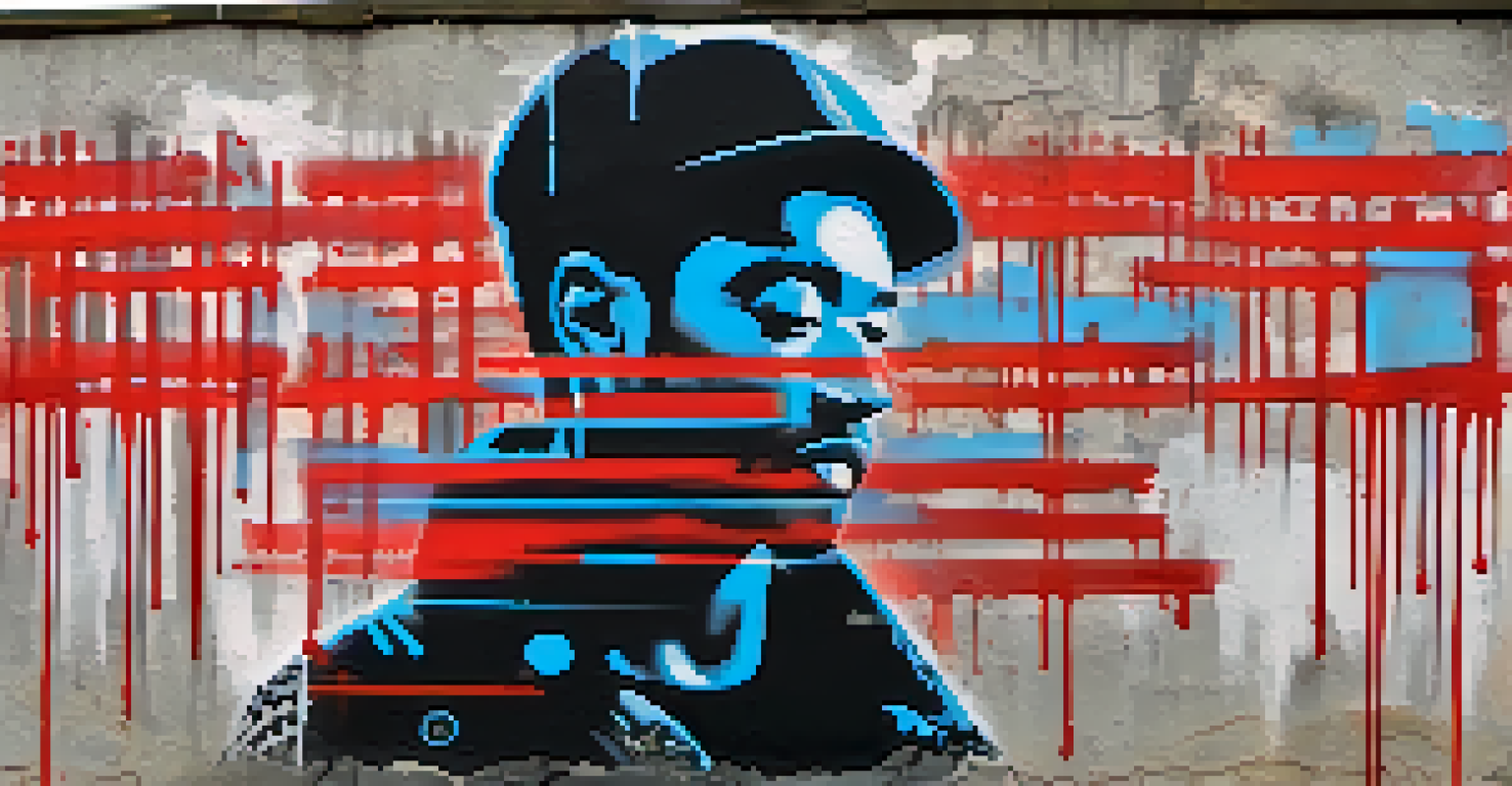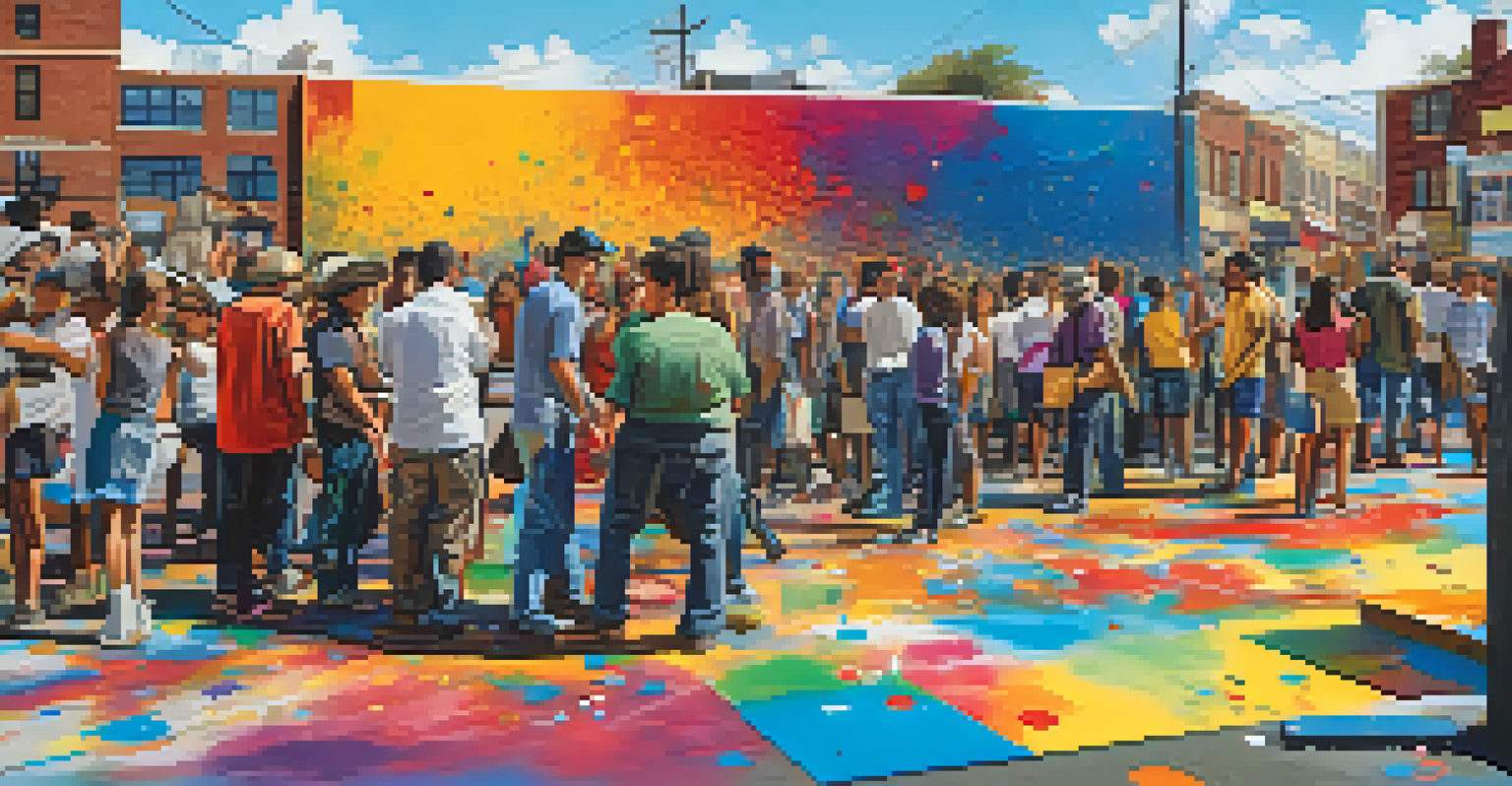Street Art and Its Influence on Urban Revitalization

Understanding Street Art: More Than Just Graffiti
Street art encompasses a wide range of artistic expressions, from murals to stencil art, that emerge in public spaces. Unlike traditional graffiti, which is often seen as vandalism, street art carries a message, telling stories about community, culture, and identity. Artists use their work to reflect social issues, engage the public, and transform ordinary walls into vibrant canvases that spark conversations.
Art is not a mirror to hold up to society, but a hammer with which to shape it.
This artistic movement is rooted in the idea of reclaiming public spaces and making art accessible to everyone, not just those who visit galleries. By bringing art to the streets, these creators invite people to see their environment through a different lens. Consequently, street art can foster a sense of belonging and pride within communities, bridging gaps between diverse groups and encouraging dialogue.
Moreover, street art often challenges the status quo, addressing issues like inequality, gentrification, and environmental concerns. These bold messages can resonate deeply with viewers, prompting them to reflect on their surroundings and the changes happening in their neighborhoods. In doing so, street art becomes a powerful tool for social change, urging communities to take action.
The Role of Street Art in Urban Revitalization
Urban revitalization focuses on improving neglected areas, making them more attractive and functional for residents and visitors alike. Street art plays a crucial role in this process by transforming dull, abandoned spaces into engaging environments. Colorful murals and installations draw attention, inviting people to explore and appreciate their surroundings, which in turn spurs economic development.

When artists come together to beautify a neighborhood, they not only enhance its aesthetic appeal but also foster community involvement. Local businesses often benefit from increased foot traffic, as people are more likely to visit areas that showcase vibrant street art. This boost in visibility can lead to higher sales, helping struggling businesses thrive and creating jobs in the process.
Street Art Transforms Communities
Street art revitalizes neglected areas, fostering community pride and dialogue through vibrant artistic expressions.
In cities like Philadelphia and Berlin, street art has become synonymous with revitalization efforts. Neighborhoods once seen as unsafe or uninviting have transformed into thriving hubs of creativity and culture. As these areas gain recognition for their artistic contributions, they attract tourists and new residents, leading to a cycle of growth that uplifts the entire community.
Case Studies: Successful Street Art Projects
Several cities around the globe have embraced street art as a means to revitalize urban areas. One notable example is the Wynwood Walls in Miami, which turned a once-neglected warehouse district into a world-renowned outdoor street art gallery. Artists from around the world have contributed their work, making it a vibrant tourist destination that showcases creativity and community spirit.
Public art is about making art accessible to everyone, not just those who visit galleries.
Another inspiring case is the Mural Arts Program in Philadelphia, which partners with local artists to create large-scale murals that reflect the city’s history and culture. This initiative not only beautifies neighborhoods but also provides job training and opportunities for local residents. The murals have become a symbol of pride and unity, strengthening the bonds between community members.
These projects highlight the potential of street art to catalyze change and foster collaboration among artists, residents, and local businesses. By involving the community in the creative process, these initiatives ensure that the art resonates with the people who live there, creating a sense of ownership and a greater appreciation for the transformed spaces.
Street Art as a Tool for Community Engagement
Street art not only beautifies urban landscapes but also serves as a platform for community engagement. By inviting local residents to participate in mural projects, artists can create a sense of collective ownership over their environment. This involvement fosters pride in one’s neighborhood and encourages community members to take an active role in its upkeep and development.
Workshops and collaborative art events allow residents to express their ideas and stories through art. These initiatives can break down barriers and spark dialogue, fostering a sense of unity among diverse groups. When people come together to create something beautiful, it cultivates relationships and a shared sense of purpose that can lead to lasting change.
Art as a Catalyst for Change
By addressing social issues, street art engages residents and encourages collective action for urban improvement.
Moreover, street art can serve as a voice for marginalized communities, giving them a platform to share their experiences and struggles. By amplifying these voices, artists can raise awareness of social issues and inspire action within the community. As a result, street art becomes a catalyst for both personal and communal growth.
Challenges and Controversies Surrounding Street Art
While street art has many positive impacts, it also faces challenges and controversies. One significant issue is the fine line between art and vandalism. Some critics argue that unauthorized street art can contribute to urban decay, while supporters contend that it revitalizes neglected areas and gives them character. This debate often leads to discussions about the role of public art and the rights of artists.
Additionally, as neighborhoods become popular due to street art, gentrification can occur. Rising property values may displace long-time residents and change the character of the community. In some cases, street artists are pushed out as commercial interests take precedence over artistic expression. This raises important questions about who benefits from urban revitalization and whether the original community's voice is being preserved.
Ultimately, navigating these challenges requires a balance between artistic freedom and community needs. Engaging with local residents and stakeholders can help ensure that street art initiatives remain inclusive and beneficial for all, creating spaces that celebrate creativity while honoring the history and identity of the neighborhood.
The Future of Street Art in Urban Spaces
As cities continue to evolve, the role of street art in urban spaces is becoming more prominent. With the rise of social media, street art can reach a global audience, allowing artists to share their work and messages far beyond their local communities. This visibility can inspire others to engage with or create their own street art, further enriching the urban landscape.
Moreover, many cities are now recognizing the value of street art and are actively supporting artists through grants, festivals, and designated public art spaces. This shift has led to a more collaborative relationship between city officials and artists, allowing for innovative projects that reflect the community's identity while enhancing public spaces.
Challenges of Street Art's Popularity
As street art gains recognition, it faces challenges like gentrification and the balance between artistic freedom and community needs.
As we look toward the future, street art has the potential to continue driving urban revitalization efforts and fostering community connections. By embracing this form of expression, cities can cultivate vibrant, inclusive environments that celebrate creativity and encourage dialogue among residents.
Conclusion: Celebrating the Power of Street Art
In conclusion, street art is a dynamic force in urban revitalization, transforming neglected spaces into vibrant canvases that reflect the community’s spirit. By engaging residents and sparking conversations around social issues, street art fosters a sense of belonging and pride among community members. It empowers artists and locals alike to take ownership of their environment, creating a unique bond that enriches the urban landscape.
Despite the challenges it faces, the future of street art looks promising. As cities increasingly recognize its value, we can expect to see more collaborative projects that celebrate creativity and diversity. This evolution not only beautifies neighborhoods but also strengthens the fabric of communities, making them resilient and adaptive to change.

Ultimately, street art serves as a reminder of the power of creativity in shaping our world. It invites us to see beauty in unexpected places and encourages us to take an active role in our surroundings. Whether through a breathtaking mural or a simple stencil, street art has the potential to inspire, provoke, and revive urban spaces, leaving a lasting impact on us all.